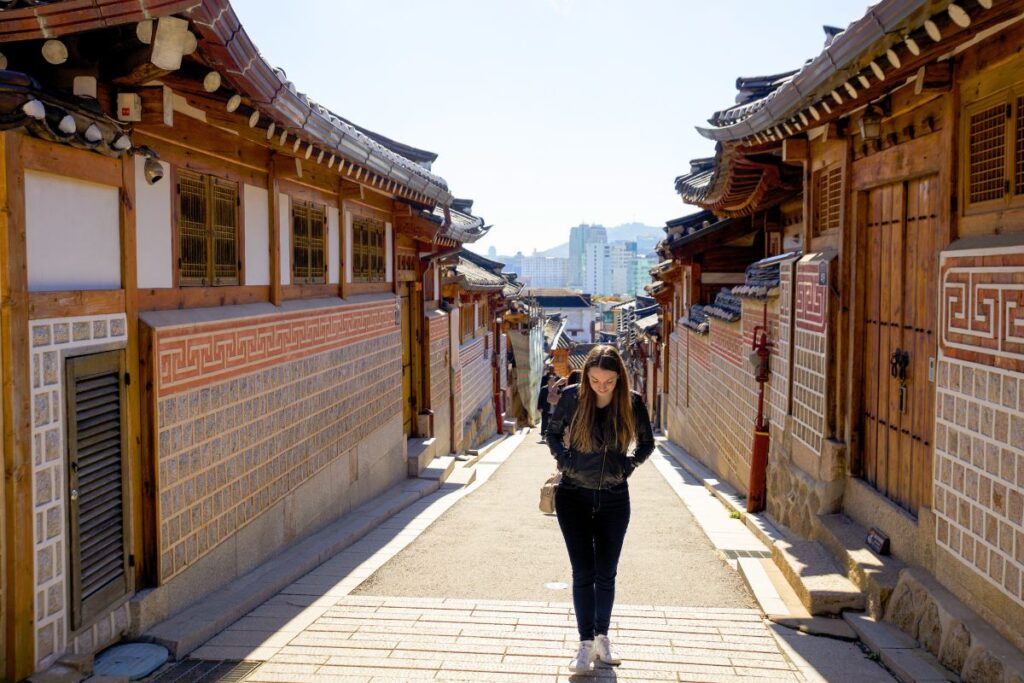
Last updated on March 2, 2024 by Krysti
Looking to spend a weekend in Seoul?
Don’t worry! I’ve got you covered with this ultimate guide to 2 days in Seoul!
Known for its rich history, vibrant culture, delectable cuisine, and modern metropolitan vibe, Seoul is not only Korea’s capital city, it’s also one of its most famous destinations.
I recently spent a few days exploring Seoul on my first-ever trip to Korea and absolutely loved it! The city is massive, it’s diverse, it’s historical, it’s lively, and it has so much to offer!
In fact, I’m already planning a second trip back so that I can see everything I missed out on the first time around. And to be honest – I may need to schedule a third and possibly fourth trip to truly see it all.
That being said, Seoul is an incredible city, no matter how much time you have to spend there. Even if it’s just a quick 2 day excursion, you’re bound to have an unforgettable time.
So, what exactly should you do when you visit Seoul? When should you go? And what should you prioritize?
We’ll discuss all of this and more as we plan out the perfect Seoul 2 day itinerary.
Best Time to Travel to Seoul
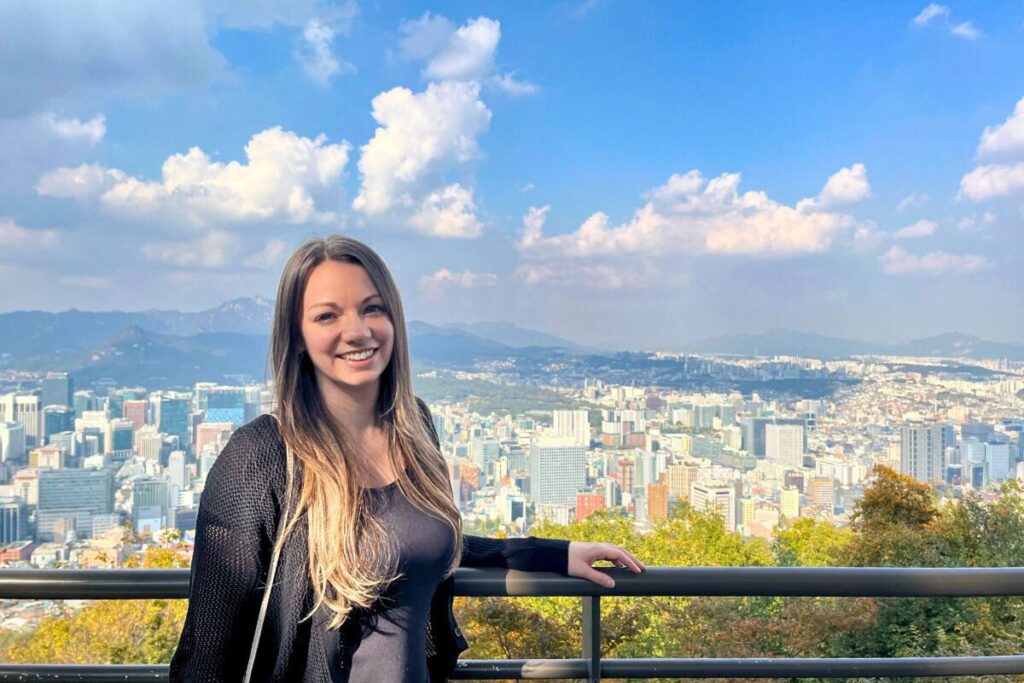
We visited Seoul in the fall and had perfect weather!
While Seoul has something to offer for every season, the best time to visit the city is in the spring or the fall.
Specifically, March to May and September to November are when you’re most likely to encounter the best weather with moderate temperatures and minimal rain.
Spring and fall also offer some of the prettiest scenery with the arrival of cherry blossoms and autumn leaves.
That being said, these seasons are some of the most popular for tourists. So you should be prepared for larger crowds and busier attractions, especially around cherry blossom season.
If you wish to avoid this, you can instead travel to Seoul during the winter months.
While winter in the city can be quite cold, you’re less likely to encounter large crowds. On top of this, there are more opportunities for outdoor activities like skiing and snowboarding.
Finally, summer is another option, if you don’t mind the heat and humidity. Just keep in mind that this is the rainiest time of the year for Seoul and the city can be quite crowded with international tourists.
A Note on Korean Holidays
There are a few major holidays in Korea that can significantly impact travel. These include the Korean New Year (late January to mid-February) and Chuseok or the Harvest Festival (mid-September to early October).
During these holiday periods, domestic travel peaks, prices increase significantly, and businesses may temporarily close down. Given this, I generally recommend, if at all possible, that visitors avoid travel to Korea around these holidays.
How to Get to Seoul
There are two main airports that service Seoul, Incheon International Airport (ICN) and Gimpo International Airport (GMP).
While Incheon Airport lies about 60 kilometers west in the city of Incheon, Gimpo is located within Seoul about 15 kilometers from the downtown area.
Gimpo was originally the main airport for Seoul; however, in 2001, the city built a new, larger airport in Incheon to help accommodate an increase in tourism.
Today, Incheon is the main airport for international tourists traveling to Seoul – and the one that you’re most likely to fly into.
The best way to travel between the city and both airports is via the Airport Railroad Express Train (AREX). This high-speed train can get you to downtown Seoul from Incheon in about an hour; meanwhile, the train ride from Gimpo takes approximately 20 minutes.
Alternatively, you can also take a taxi or travel via an airport limousine bus. However, both options typically take a bit longer, as you’ll have to navigate city traffic.
For those traveling within Korea, there are a few train stations in Seoul that you can utilize; however, Seoul Station is the main station for the city. It’s also the only one that is serviced by the Korea Train Express (KTX).
Pro Tip: If you plan to travel to several cities within Korea, consider purchasing a Korail Pass. This pass allows for unlimited rides on the KTX to more than 600 stations over a specified period of time.
How to Get Around Seoul
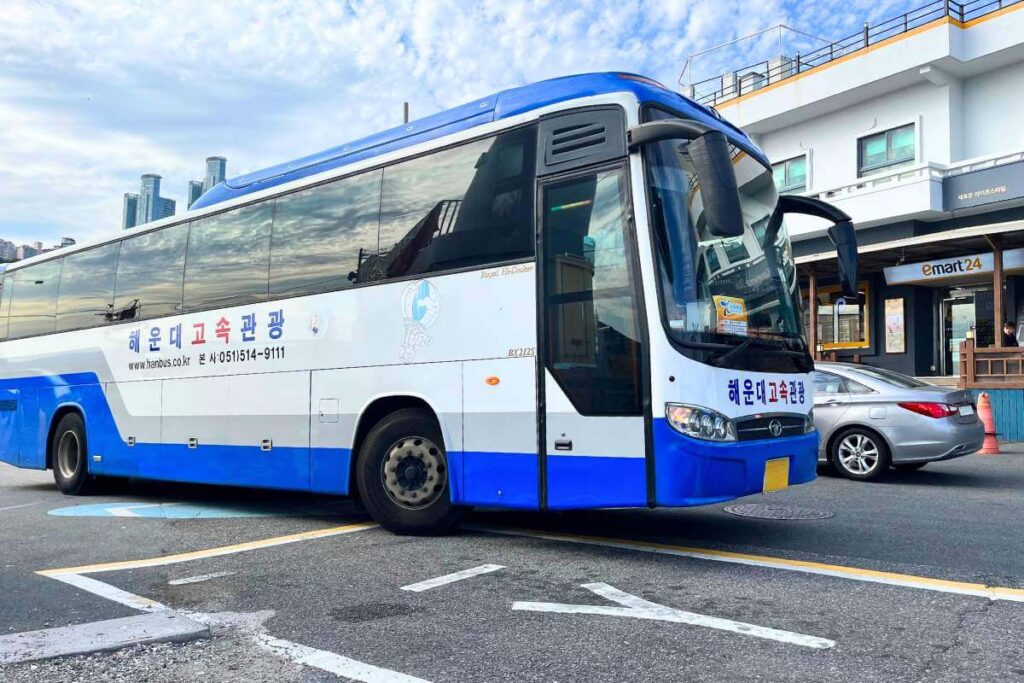
Buses are a common form of public transportation in South Korea.
Even though Seoul is quite spread out, it’s still relatively easy to get around the city.
To begin with, public transportation in Seoul is super quick, convenient, reliable, and affordable.
There’s an extensive network of subways and buses that accommodate most of the city and can get you just about anywhere.
To utilize this transportation, you will need to obtain a T-Money Card. Which is essentially a reloadable transportation pass that provides access to most forms of public transit in Korea.
This means you can use the same card for local trains, buses, and subways, not just in Seoul, but in cities all across the country.
T-Money Cards can be purchased from convenience stores. And they can be topped up at specified kiosks in many subway and bus stations.
Alternatively, you can also utilize taxis to get around the city. And, truth be told, sometimes a taxi can be faster, depending upon where you are and where you’re headed.
While you can hail taxis down right from the street, one of the easiest ways to reserve them is through Kakao T. This Korean travel app allows users to find, request, track, and communicate with taxi drivers – all in English.
Pro Tip: Typical navigation apps like Google Maps and Apple Maps don’t work in South Korea. You’re better off using a local South Korean app like Naver Map or KakaoMap to get around Seoul.
Map of Seoul
To help you plan your trip, here’s a quick map overview of all the places mentioned in this 2 day Seoul, Korea itinerary.
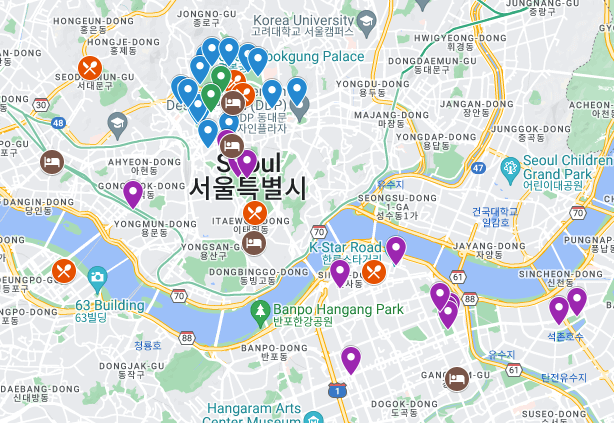
If you’d like to view an interactive version of this map, click here!
Seoul 2 Day Itinerary: An Overview
Don’t have time to read the article in full? Here’s a quick recap of my suggested itinerary for 48 hours in Seoul.
- Day 1 – Traditional Seoul: Discover the Royal Palaces of Seoul and explore Bukchon Hanok Village. Stop by the local markets and sample traditional Korean street food.
- Day 2 – Seoul City Highlights: Visit N Seoul Tower and Gangnam District. Spend an afternoon cafe hopping and/or try out a few K-Beauty treatments.
Seoul 2 Day Itinerary: Explained
On that note, let’s dive in and discuss in detail the perfect Seoul itinerary for 2 days. I’ve included numerous options for you to consider, as well as some alternative activities. Feel free to pick and choose and adapt this itinerary as you see fit!
Day 1: Traditional Seoul
Your first day in Seoul will focus mainly on the traditional and cultural aspects of the city. There are several destinations that you can visit; however, don’t feel pressured to see it all. This first day will vary depending on when you arrive in Seoul and how much time you have to explore.
Visit the Historical Palaces of Seoul
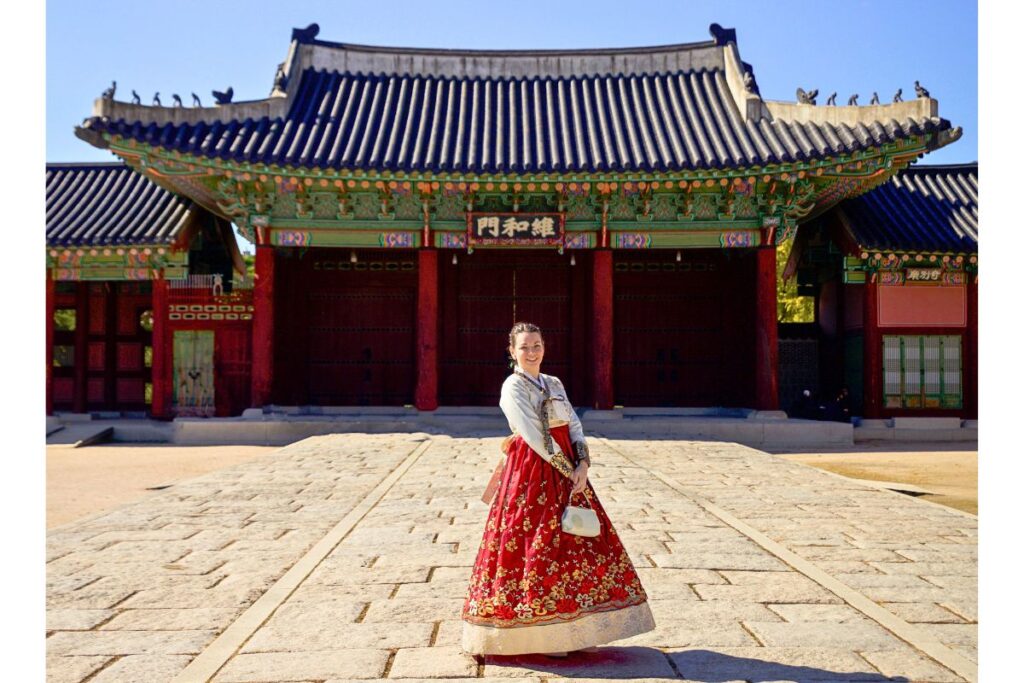
Gyeongbokgung Palace in Seoul.
The city of Seoul is home to a total of five royal palaces. They’re all located within the same area, so it is possible to visit them all in one go. However, this can be a bit much to try and accomplish – especially if you want to check out other nearby attractions.
As such, I recommend choosing just one or two that interest you, so you have enough time to explore them in full.
Pro Tip: If you show up wearing traditional Korean attire, you can get into the palaces for free! There are clothing rental stores all over the city, just look for signs that say, “Hanbok Rental.”
Gyeongbokgung Palace
The largest palace in Seoul, Gyeongbokgung served as the main residence and center of government during the Joseon dynasty. Dating back to the 1300s, the palace complex is home to several royal halls, ornate pavilions, vibrant gardens, as well as the National Palace Museum Of Korea and the National Folk Museum of Korea.
In addition to this, the palace is known for its Royal Guard Changing Ceremony, which is held twice a day in front of the main gate.
Changdeokgung Palace
A UNESCO World Heritage Site, Changdeokgung is one of the most well-preserved palaces from the Joseon dynasty. Built during the 15th century, it features the royal residential halls, a royal shrine, and an expansive garden, dubbed the Secret Garden.
This garden is especially popular during the fall and spring months when it becomes blanketed with autumn leaves and cherry blossoms.
Please note: Admissions into the Secret Garden is limited, so it’s best to reserve your tickets ahead of time.
Deoksugung Palace
Dating back to the 16th century, Deoksugung was originally built as a royal residence, but later became the imperial court for the unified Korean Empire. While many of its original buildings have been absorbed by the city, what remains is a unique mix of traditional Korean architecture and Western-influenced buildings.
It’s also worth noting that the palace is home to the Daehan Empire History Museum and a branch of the National Museum of Modern and Contemporary Art.
Changgyeonggung Palace
Built as a royal residence during the 15th century, Changgyeonggung has been destroyed multiple times over the years. The victim of fires, invasions, and colonial occupation, the palace was finally restored and returned to its former glory in 1983.
Today, the complex houses several royal residential halls, an expansive pond, lush greenery, and an impressive greenhouse.
Gyeonghuigung Palace
Dubbed the “West Palace,” Gyeonghuigung was built in the 17th century as a secondary palace during the Joseon dynasty. Once home to approximately 100 buildings, the palace complex is now one of the smallest in Seoul. It also happens to be the least-visited and least-crowded, despite its free admissions.
As a side note, Gyeonghuigung is located right next to the Seoul Museum of History, which is one of the city’s most famous museums.
Wander the Streets of Bukchon Hanok Village
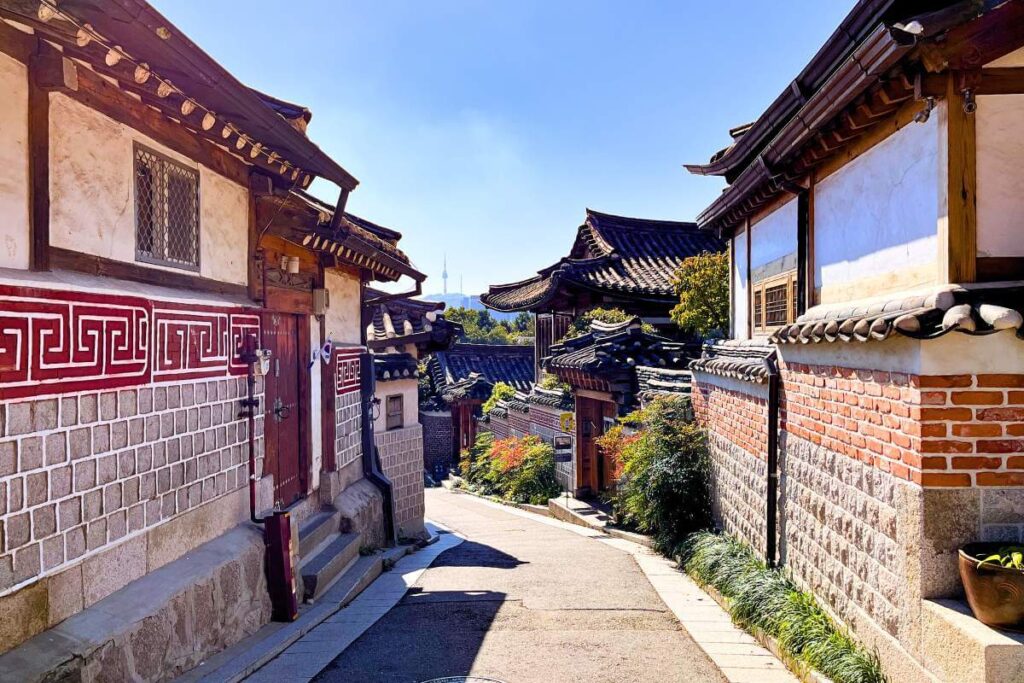
Also known as the “Northern Village,” Bukchon is a Korean neighborhood that houses more than 900 traditional homes.
Dating back to the Joseon dynasty, this collection of homes is the largest concentration of traditional Korean houses in Seoul.
Given its popularity among tourists, many of these houses have been converted into cafes, restaurants, guest homes, and tea houses.
That being said, a large number of locals still live in the neighborhood; so if you visit, it’s important to remain quiet and respectful at all times.
Please Note: Bukchon’s visiting hours are Monday to Saturday from 10 am to 5 pm. The neighborhood is closed to visitors on Sundays.
Explore Seoul’s Bustling Street Markets
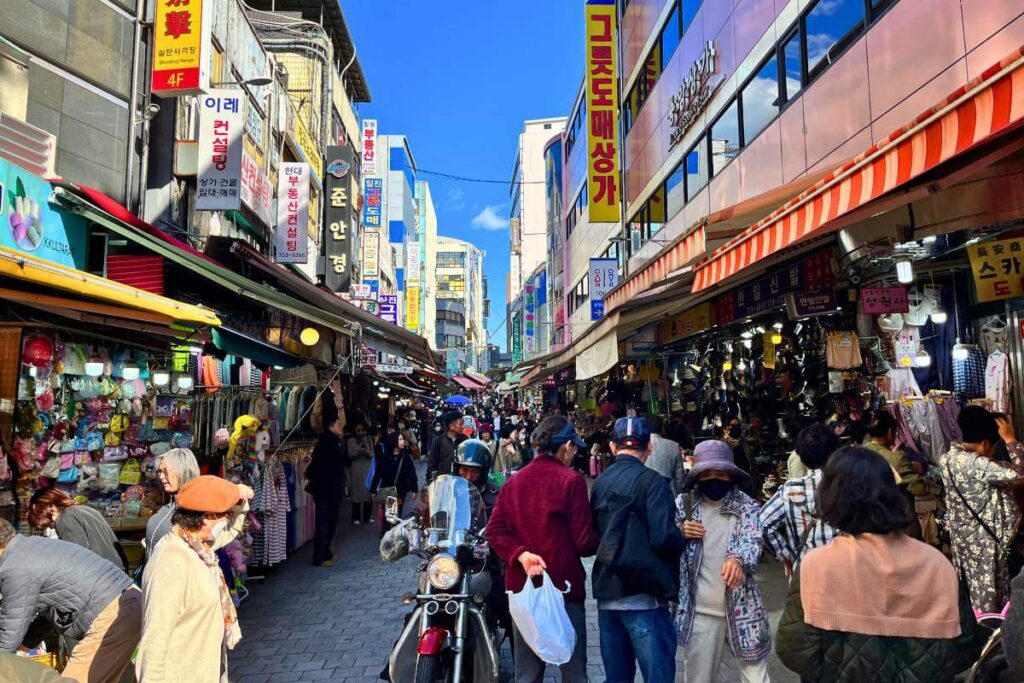
Namdaemun Market in Seoul.
Seoul is home to a number of vibrant traditional street markets. Spread throughout the city, they offer a variety of goods, including souvenirs, clothing, jewelry, accessories, and of course street food.
While there are several that you can visit some of the most popular include:
- Namdaemun Market: Dating back to the 15th century, Namdaemun is Korea’s oldest and largest street market. Here you’ll find everything from clothing to electronics, home goods, souvenirs, and a wide variety of street food.
- Gwangjang Market: Celebrated for its delectable food offerings, Gwangjang is said to be the best market in the city for traditional authentic Korean street food. From tteokbokki to bibimbap, hotteok, dumplings, and seafood, you can sample just about everything here.
- Myeong-dong Night Market: Open from 5 pm to 1 am, Myeong-dong Night Market is the best place to go for late-night snacks and shopping. Here you’ll find a variety of street food vendors, as well as clothing and cosmetic stores.
- Dongdaemun Market: A shopping district spanning ten blocks, Dongdaemun Market is home to more than 30,000 stores and 20 shopping malls. Known most famously for its textiles, this market has become Seoul’s go-to spot for all things fashion-related.
Day 2: Seoul City Highlights
On your second day in Seoul, we’ll partake in some of the city’s most famous activities. I recommend beginning your day at N Seoul Tower, followed by Gangnam District. You can then spend your afternoon visiting local cafes and/or parking in K-Beauty treatments.
Take in the Views from N Seoul Tower
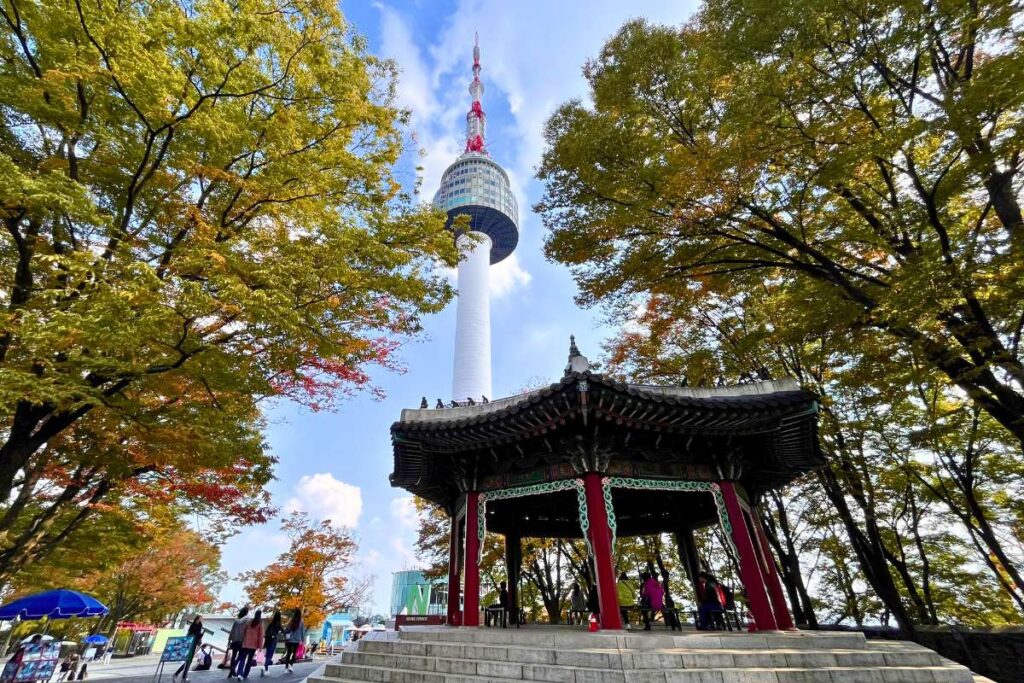
Situated at the top of Mt. Namsan within Namsan Park lies Seoul’s most iconic landmark, the N Seoul Tower.
Measuring 239 meters in height, the tower offers incredible views of Seoul and the surrounding landscape.
There are three observation decks for you to explore, as well as a number of restaurants, gift shops, and cafes.
The tower is reachable by bus, car, and walking trail. Or, for those who aren’t afraid of heights, there’s also the Namsan Cable Car, which travels over Mt. Namsan to N Seoul Tower.
Discover the Appeal of Gangnam District
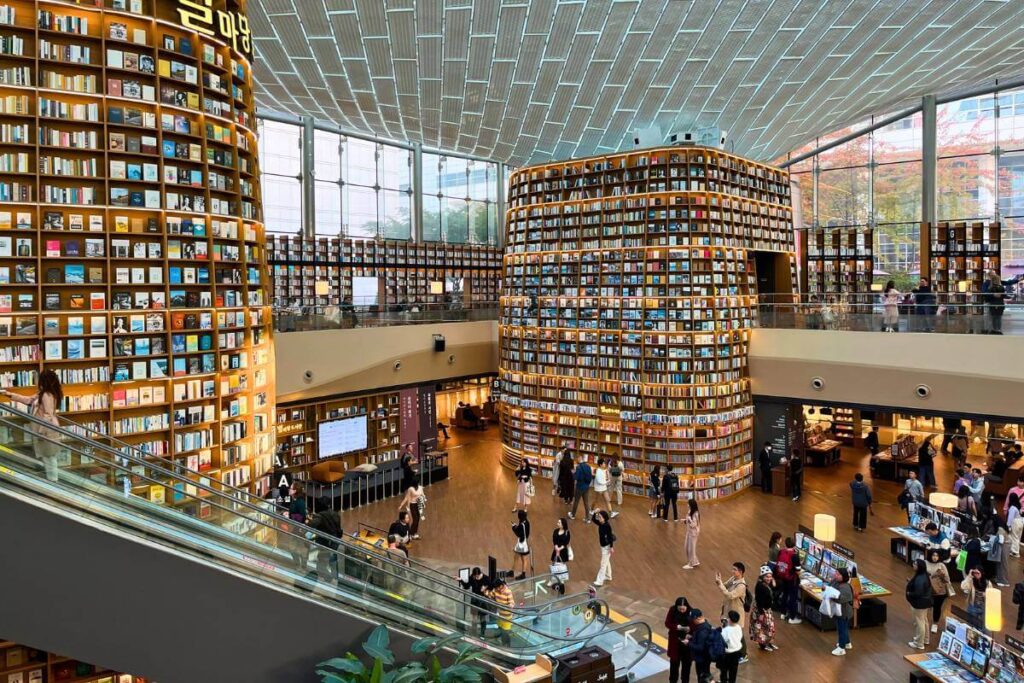
The Starfield Library inside COEX Mall is located in Gangnam District.
Made famous by the K-pop hit “Gangnam Style,” the district of Gangnam has so much to offer beyond its musical roots.
To begin with, Gangnam is one of the premier shopping areas in the city of Seoul. From boutique stores to thrift shops, high-end shopping centers, and massive malls, Gangnam has it all.
Some of the most popular shopping destinations include Garosu-gil Street, Lotte World Mall, Gangnam Station Underground, and Starfield Coex Mall, where you can also find the famous Starfield Library.
In addition to this, Gangnam is home to several popular attractions like Bongeunsa Temple, K-Star Road, Lotte World Theme Park, and, of course, the Gangnam Style Statue.
Spend an Afternoon Cafe Hopping
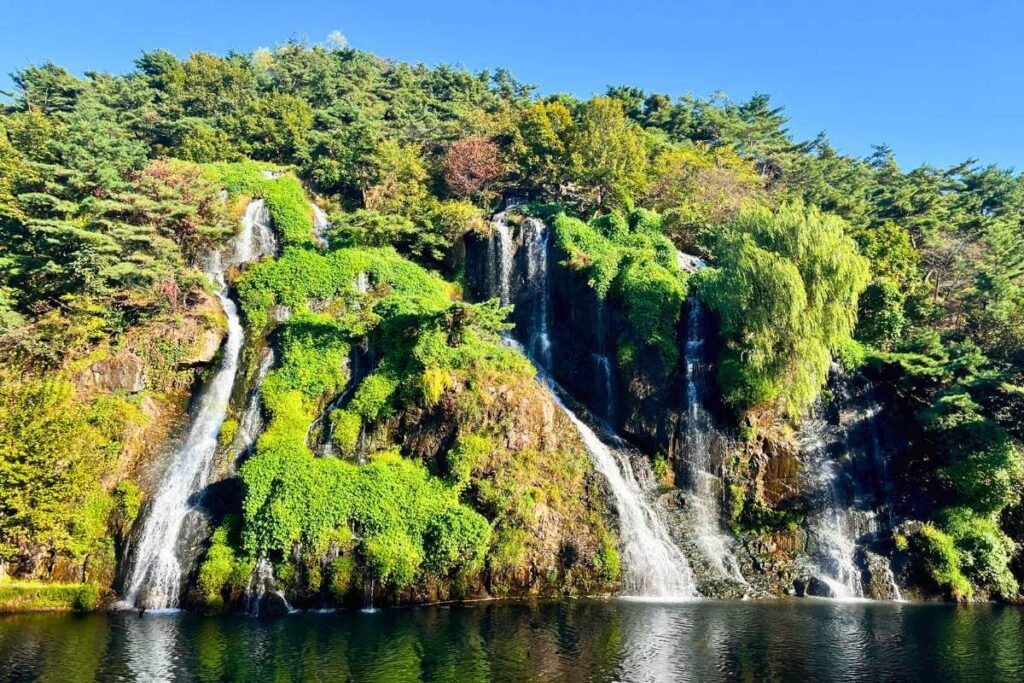
The view from Cafe Pokpo in Seoul.
Seoul is known for its trendy and cute cafes, so be sure to set aside some time to visit them. They’re not only visually appealing – they’re also delicious!
Here are a few popular cafes that you can add to your 2 day Seoul itinerary:
- Cafe Pokpo: Home to several cascading waterfalls, Cafe Pokpo offers some of the best views around.
- Mammamia: Inspired by the movie of the same name, Mammamia Cafe features a Greece-like atmosphere and character-named sweets.
- Cafe Onion Anguk: Situated within a traditional Korean Hanok, Cafe Onion Anguk is one of the most famous cafes in Seoul.
- Cafe Layered: Offering multiple locations, Cafe Layered is known for its delectable cakes and scones.
- Cheongsudang Cafe: Embracing a natural, aquatic theme, Cheongsudang Cafe is home to beautiful gardens and water features.
- Rain Report: Another water-themed cafe, Rain Report features artificial rain and a plethora of other water-inspired decor.
Pro Tip: These cafes can get quite busy, so it’s best to visit them early or after the lunch rush has subsided!
Partake in K-Beauty Treatments
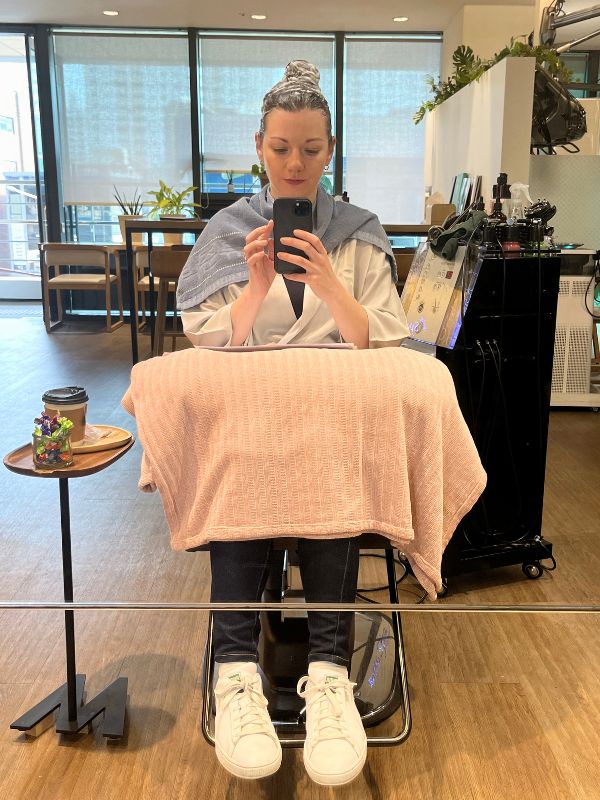
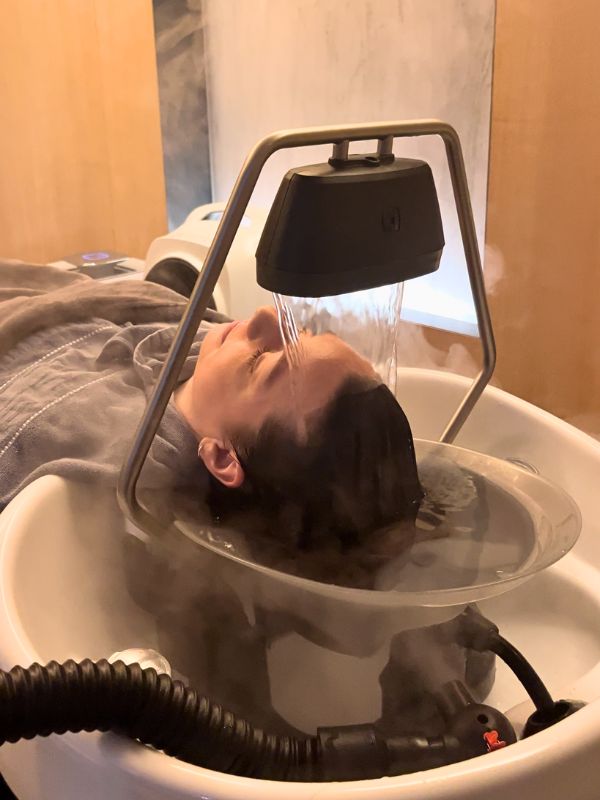
South Korea is renowned across the world for its K-beauty treatments. And the best part is – they’re super affordable!
While I was in Seoul, I booked a head spa at EcoJardin and it was absolutely wonderful!
I did the 15-step scalp treatment, which included cleansing, exfoliation, and treatment of the scalp, along with a neck massage and waterfall head spa. And, honestly, my hair and scalp have never felt better.
In Seoul, you can also get a variety of skin care treatments done, including facials, LED light therapy, botox, filler, etc.
And, you don’t even really need to worry about a language barrier. Because many of these facilities cater to foreign clients and have multi-lingual staff on hand.
Pro Tip: If you plan to partake in any beauty treatments, make sure to schedule your appointments ahead of time. Many of these facilities are known to book up weeks, if not months, in advance.
Other Things to Do in Seoul
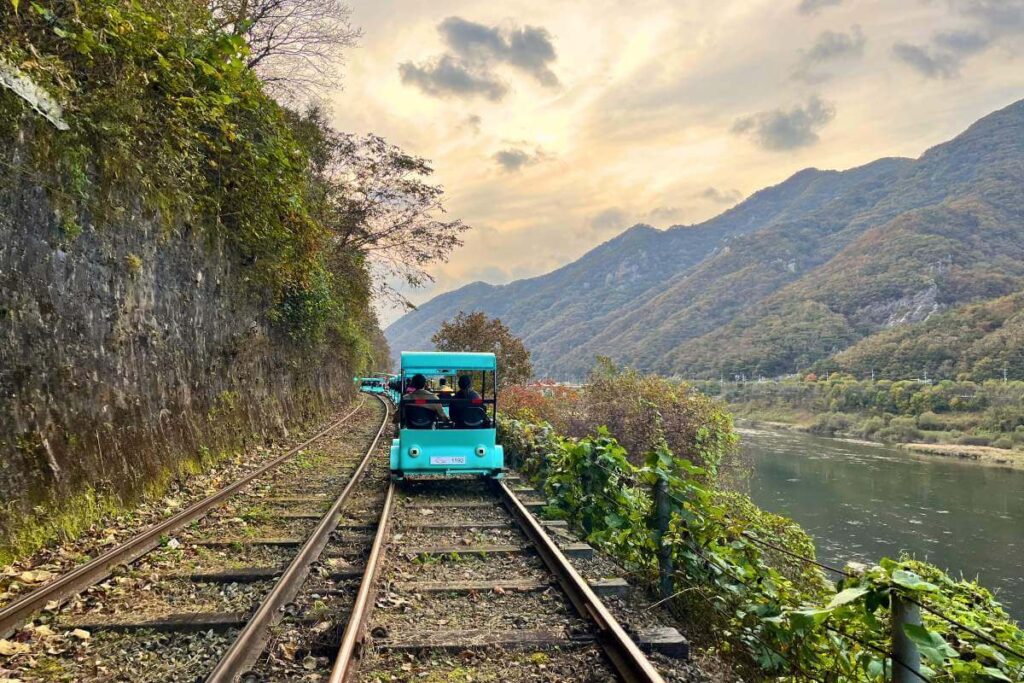
The course for Gangchon Rail Bike located just outside of Seoul.
Interested in adjusting this 2 day Seoul itinerary? Or maybe you’re contemplating a longer stay? If so, consider visiting some of these other popular attractions as well.
- Jogyesa Temple: Dating back to the 14th century, Jogyesa is the chief temple of modern Buddhism in Korea. Open to visitors 24 hours a day, the temple complex features several worship halls, a ten-story relic stupa, numerous statues of Buddha, and a revered 500-year-old tree.
- Cheonggyecheon Stream: Cutting through downtown Seoul, Cheonggyecheon is a 10.8-kilometer-long stream that features waterfalls and walking trails. Along its banks, you’ll find colorful statues, light displays, mosaics, and art installations.
- Bukhansan National Park: Situated just outside of Seoul, Bukhansan National Park encompasses two mountains, Bukhansan and Dobongsan Mountain. Spanning approximately 31 square miles, the park is a popular spot for hiking, rock climbing, camping, fishing, and biking.
- Nami Island: A popular day trip from Seoul, Nami Island is located about 2 hours west of the city. Made famous by the Korean film industry, the island is home to lush greenery, tree-lined walkways, small cafes, water sport activities, and several child-friendly attractions.
- Gangchon Rail Park: Created out of repurposed train tracks, Gangchon Rail Park is home to a rail bike course that winds across the countryside near Seoul. Spanning 8.5 kilometers, the course travels through themed tunnels, past serene lakes, and around majestic mountains.
- DMZ Tour: Running along the border with North Korea lies the Korean Demilitarized Zone, a heavily guarded area that divides the two countries. You can join organized tours from Seoul if you wish to visit this area and learn more about the history of North and South Korea.
Where to Stay in Seoul
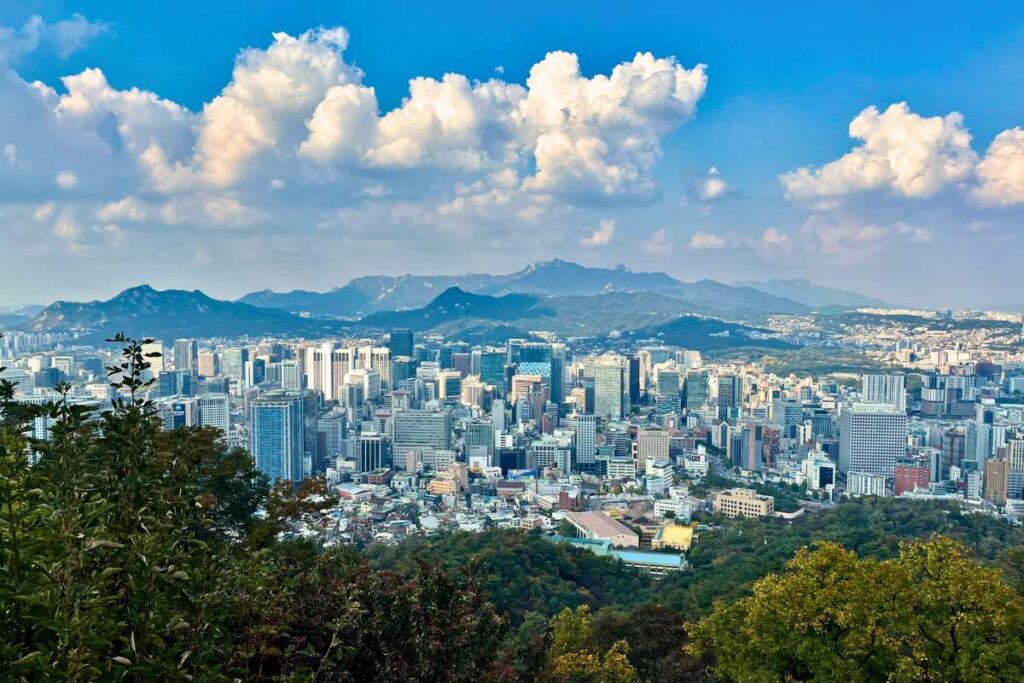
View of Seoul from N Seoul Tower.
Seoul is a large city with a variety of accommodation options for you to consider. Where you decide to stay will largely depend on your budget, itinerary, and personal preferences. That being said, I’ve included below some of the most popular places to stay in Seoul for a 2 day itinerary.
- Insadong: Set within historic Seoul, Insadong offers easy access to a number of cultural attractions, including the royal palaces and Bukchon Hanok Village. In addition to this, the area is home to several traditional tea houses, restaurants, and accommodation options.
- Myeongdong: Centrally located, Myeongdong is one of the most popular places to stay for first-time visitors to Seoul. Here you’ll find a variety of restaurants, bars, shopping centers, street food vendors, and affordable accommodations.
- Hongdae: Offering trendy, more laid-back vibes, Hongdae is favored by students and young travelers. The neighborhood is home to several cute cafes, late-night bars, boutique stores, and affordable accommodations.
- Itaewon: The international heart of Seoul, Itaewon is known for its diverse and multicultural atmosphere. Here you’ll find a number of foreign-friendly restaurants, bars, accommodations, and nightlife venues.
- Gangnam: Celebrated for its modern and luxurious vibes, Gangnam offers some of the best shopping and fine-dining experiences in Seoul. It’s also home to several high-end hotels, making it a perfect option for luxury travelers.
What to Eat in Seoul
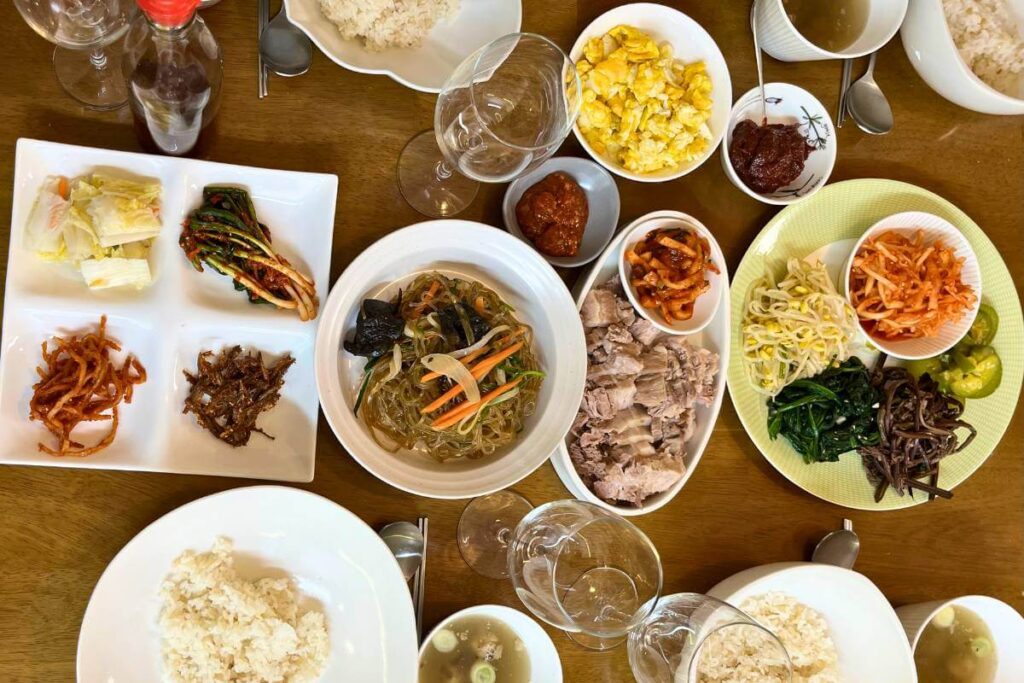
The makings of Bibimbap.
Korea is known for its incredible cuisine – and Seoul is one of the best places to try it all. While you won’t have time to sample everything, there are a few dishes that you simply shouldn’t miss.
- Korean BBQ: Featuring a variety of meat and vegetables, Korean BBQ is a popular cuisine of grilled food. Typically, gas or charcoal grills are built into tabletops, and patrons cook their own food right at their table.
- Korean Fried Chicken: Known locally as “chikin,” Korean fried chicken is similar to the fried chicken you’d have at home. The difference here is that it’s usually double-fried and is cooked with a unique variety of seasonings and sauces.
- Bulgogi: Literally translated as “fire meat,” bulgogi is made with thin, marinated strips of meat (usually beef) that have been grilled or stir-fried. It is typically served over rice or with lettuce wraps and is accompanied by side dishes such as kimchi and egg soup.
- Bibimbap: A Korean rice dish, bibimbap features white rice topped with a variety of meats and vegetables. Common toppings include marinated beef, mung beans, bean sprouts, spinach, carrots, shiitake mushrooms, kimchi, eggs, and red pepper paste.
- Gamjatang: Also known as pork bone soup, gamjatang is a spicy stew made with pork neck bones and a variety of vegetables. Many gamjatang restaurants feature hotpot-like settings, where the stew is boiled right at your table.
- Tteokbokki: A popular street food in Korea, tteokbokki is essentially chewy rice cakes that are cooked in a red sauce. Eggs and fish cakes are also sometimes added in.
- Hotteok: Found at most street markets, hotteok is a popular Korean sweet pancake. It’s typically fried and filled with some combination of sugar, honey, and cinnamon.
Frequently Asked Questions About Planning an Itinerary to Seoul
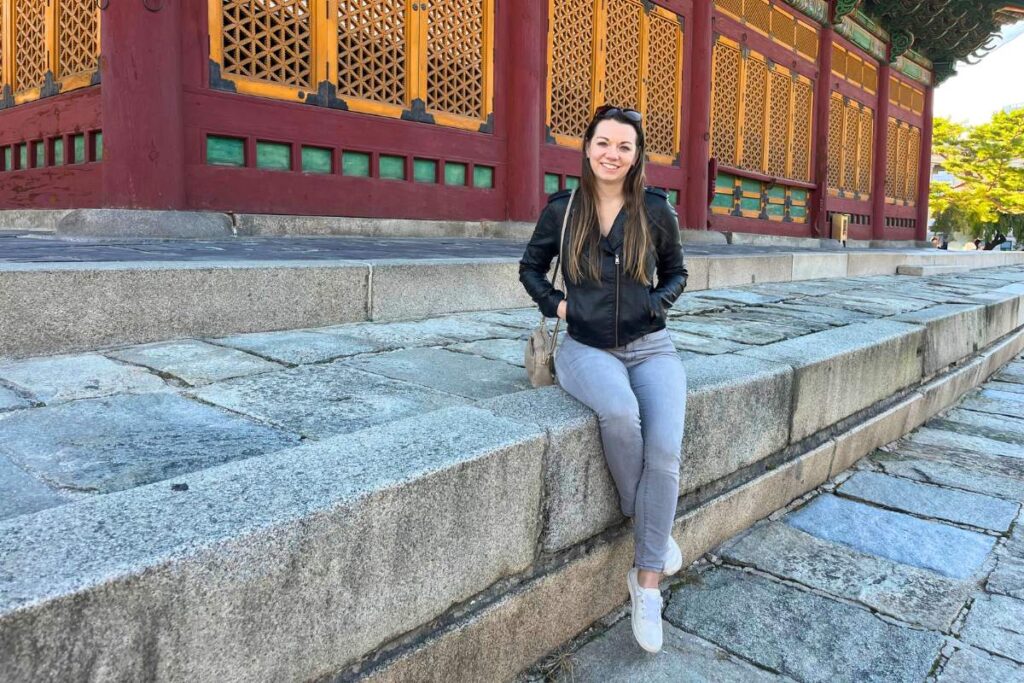
Deoksugung Palace in Seoul.
Here are my thoughts on some commonly asked questions about visiting Seoul in 2 days.
Is Seoul Worth Visiting?
Seoul is most definitely worth visiting! As Korea’s capital city, Seoul has so much to offer for visitors of all interests. From its historical attractions to its renowned museums, vibrant urban atmosphere, lively nightlife, unparalleled shopping, and incredible cuisine, there really is something for everyone to enjoy here!
Are 2 Days Enough for Seoul?
Truth be told, you’d probably need weeks, if not months, to explore all that Seoul has to offer. That being said, 2 days is still a decent amount of time to get a basic sense of the city. While you won’t be able to see everything, you’ll be able to hit up some of Seoul’s most popular attractions and highlights.
Is K-ETA Still Required for Entry into South Korea?
In celebration of the “Visit Korea Year,” South Korea put into place a K-ETA exemption for 22 countries. This exemption will remain in place through December 2024. After this, all visa-exempt tourists will be required to apply for and receive K-ETA approval before arrival. You can check your status here to determine whether or not you are required to complete a K-ETA application.
Please note: This applies to visa-exempt tourists only. If you’re traveling from a country that is not visa-exempt, you will need to complete your normal visa requirements before entering South Korea.
Can You Speak English in Seoul?
Yes, it’s possible to get by with English while visiting Seoul, if you stick to the main touristy areas. However, if you plan to travel off the beaten path at all, you should be prepared to encounter a language barrier. To help with this, I recommend downloading a translation app, like Google Translate. These types of apps can be very helpful when trying to communicate in foreign countries.
Is Seoul or Busan Better?
I personally really enjoyed both cities! They each have unique experiences to offer and equally deserve a place on your Korean itinerary. That being said, they do have their differences. As the capital city, Seoul is much bigger and, therefore, home to more urban amenities and attractions. Meanwhile, Busan is located right on the ocean in a mountainous region. So it tends to be a bit more laid back and offers more opportunities for outdoor excursions.
Pro Tip: Don’t choose between them, visit both cities! You can take the KTX from Seoul to Busan and get there in no time.
Final Thoughts: Seoul 2 Day Itinerary
So there you have it – my top recommendations for a 2 day Seoul itinerary! Hopefully, this guide is helpful in planning your own trip to Korea’s capital city.
No matter what you decide to do, you’re bound to have an unforgettable time. After all, Seoul is a vibrant and lively destination – one that truly offers something for everyone!
Planning your own 2 day itinerary for Seoul, Korea? What are you most excited to do? Let me know in the comments below!
Enjoy this 2 day Seoul itinerary? Pin it now for later!
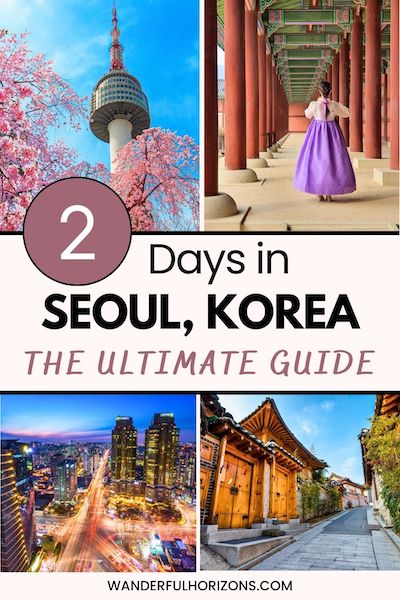
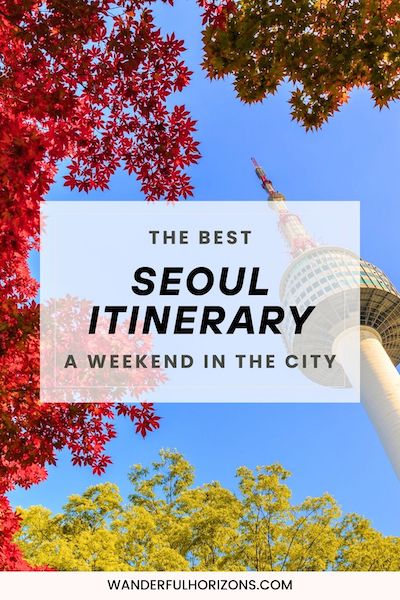
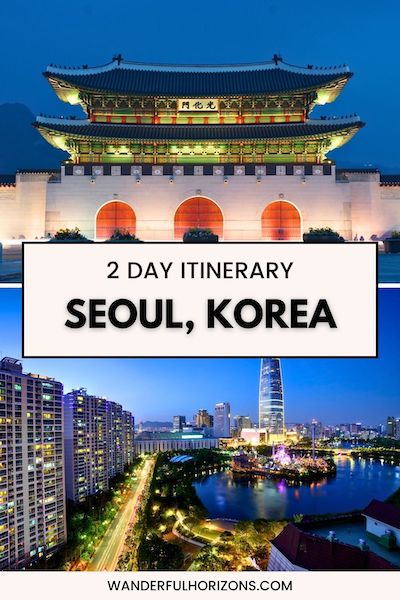

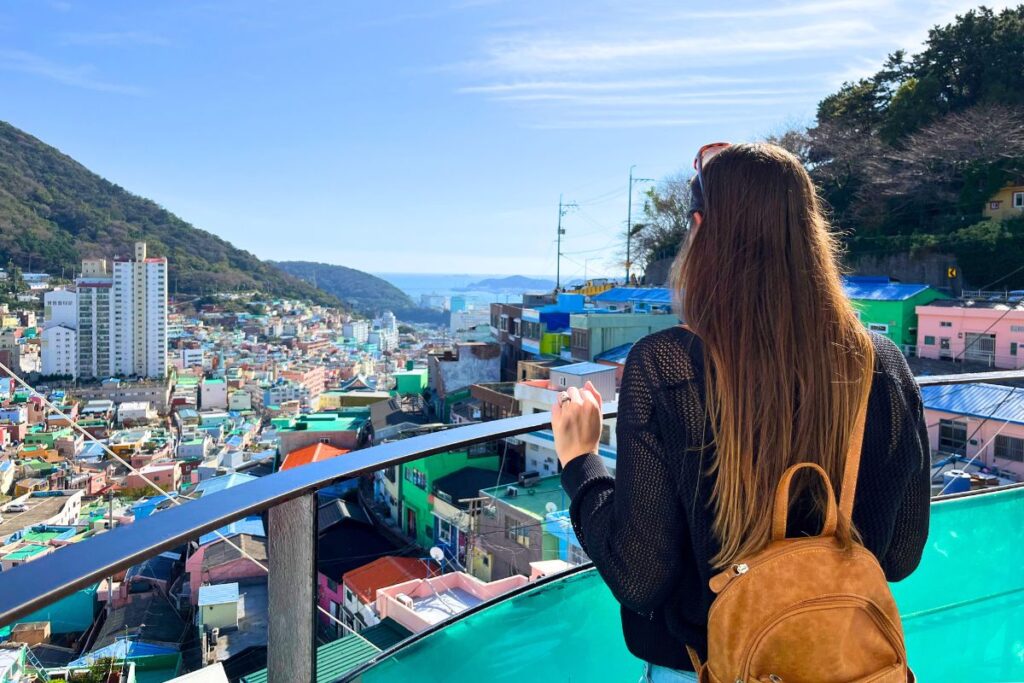
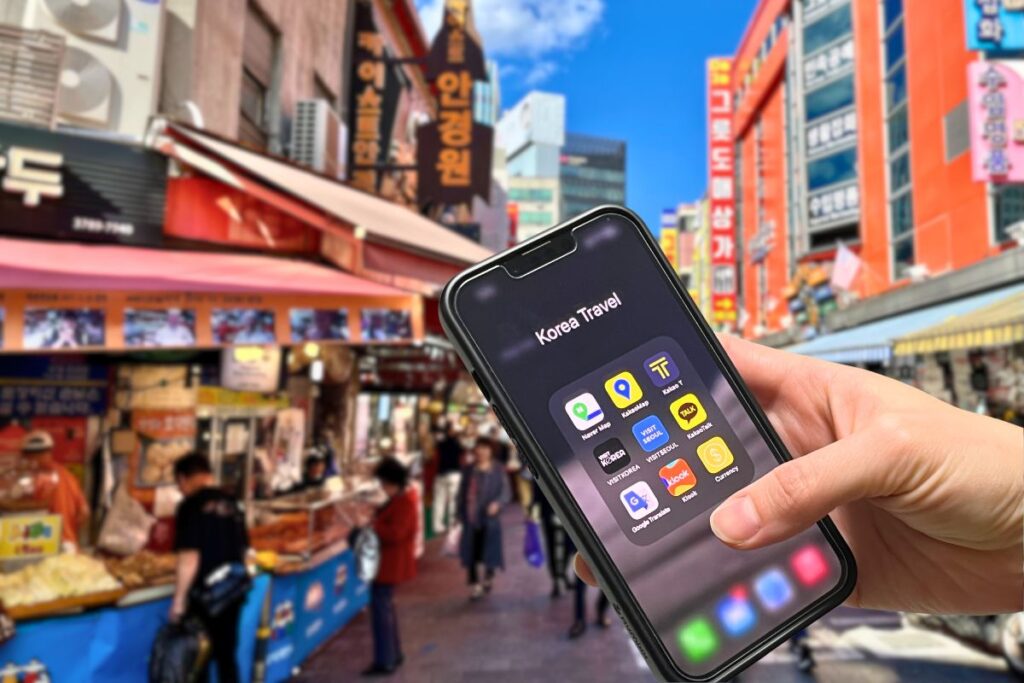
This looks like an incredible place to visit! The photos are wonderful and I’ve now officially added it to my bucket list! Thanks for sharing!
Thank you!! Seoul is a great destination – I’m glad to hear you’ve added it to your bucket list!
I’m a Korean. The travel destination information is really informative and detailed. great. I will also refer to other travel destination information. Thank you.
Thank you!! I’m glad you found the article helpful!